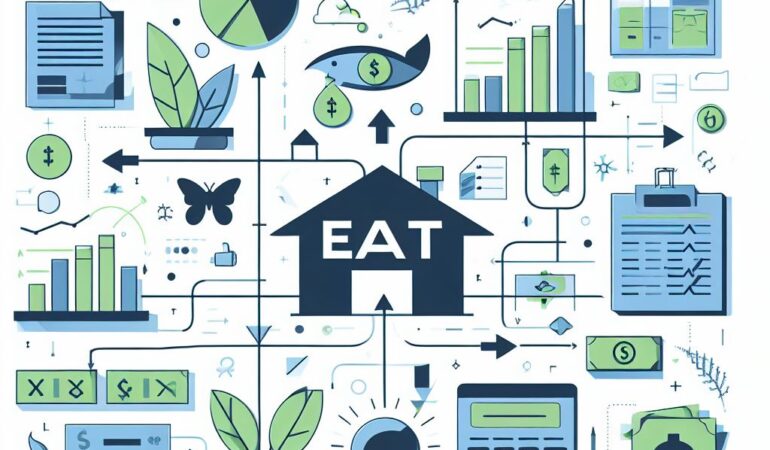Are you looking to maximize your tax benefits? Look no further! In this step-by-step EAT guide, we will show you how to make the most out of your tax deductions and credits.
From understanding the basics of the EAT program to identifying and documenting qualified expenses, we’ve got you covered.
Get ready to optimize your tax benefits with advanced strategies that will save you money. Let’s dive in!
Key Takeaways
- The EAT program is a resource provided by employers that offers counseling services, financial management resources, and legal assistance to help employees thrive personally and professionally.
- To be eligible for the EAT program, individuals must be a U.S. taxpayer with a valid Social Security number and have earned income from self-employment or a small business. They need to complete Form 1040-ES and submit it electronically or by mail to the IRS to enroll.
- It is important to understand eligible expenses for the EAT program, such as education, health care, and dependent care. Maintaining proper documentation, consulting with a tax professional if needed, and organizing records are crucial for substantiating deductions during an IRS audit.
- Maximizing deductions and credits is key in optimizing tax benefits. This can include itemizing deductions, claiming tax credits like the Child Tax Credit and Earned Income Tax Credit, and maximizing retirement contributions for tax benefits. Gathering necessary documentation and meeting eligibility requirements for available credits is important in this process.
Understanding EAT Program Basics
Do you want to know the basics of the EAT program? Well, you’ve come to the right place!
The EAT program, also known as the Employee Assistance Program, is a valuable resource provided by many employers to support their employees’ well-being. This program offers a wide range of services and benefits to help employees deal with personal and work-related challenges.
One of the key features of the EAT program is the provision of counseling services. If you’re dealing with stress, anxiety, or any other mental health issue, you can reach out to a qualified counselor who’ll provide you with the necessary support and guidance. These counseling sessions are usually confidential and can be conducted in person, over the phone, or even through online platforms.
In addition to counseling, the EAT program often includes resources for financial management. This can include workshops on budgeting, debt management, and retirement planning. By utilizing these resources, you can gain a better understanding of your financial situation and make informed decisions to improve your financial well-being.
Furthermore, the EAT program may offer assistance with legal matters. If you’re facing legal issues or need advice on matters such as contracts or family law, the program can connect you with qualified legal professionals who can provide guidance and support.
Overall, the EAT program is designed to provide you with the necessary resources and support to navigate life’s challenges. Whether it’s counseling, financial management, or legal assistance, this program is here to help you thrive both personally and professionally.
Eligibility and Enrollment Process
To be eligible for the EAT program, you must meet certain criteria and complete the enrollment process. The first step is to ensure that you’re a U.S. taxpayer and have a valid Social Security number. Additionally, you must have earned income from self-employment or a small business.
To enroll in the EAT program, you need to complete Form 1040-ES, Estimated Tax for Individuals, and include it with your tax return. This form will help you estimate your quarterly tax payments and determine your eligibility for the program.
After completing the form, you can submit it electronically using the IRS e-file system or mail it to the appropriate IRS address. Remember to keep a copy of the form for your records.
Once your enrollment is processed, the IRS will send you a confirmation notice. This notice will include your unique EAT ID, which you’ll need to reference in all future communications with the IRS regarding the program.
It’s important to note that if your enrollment isn’t approved, you’ll need to make quarterly estimated tax payments like any other taxpayer. Therefore, it’s crucial to ensure that you meet all the eligibility requirements and complete the enrollment process accurately and on time.
Identifying and Documenting Qualified Expenses
To maximize your tax benefits under the EAT program, it’s essential to accurately identify and document your qualified expenses. This step is crucial as it ensures that you claim the deductions you’re entitled to and avoid any potential issues with the IRS.
When identifying your qualified expenses, it’s important to understand what types of expenses are eligible. These can include costs related to education, health care, dependent care, and even certain business expenses. Keep in mind that not all expenses will qualify, so it’s crucial to review the IRS guidelines and consult with a tax professional if needed.
Once you have identified your qualified expenses, it’s important to maintain proper documentation. This can include receipts, invoices, cancelled checks, and any other relevant documentation that proves the expense was incurred. By keeping organized records, you’ll be able to easily substantiate your deductions if you’re ever audited by the IRS.
Now that you understand the importance of identifying and documenting your qualified expenses, it’s time to move on to the next step: maximizing deductions and credits.
Maximizing Deductions and Credits
To maximize your tax benefits under the EAT program, you can take full advantage of available deductions and credits. Here are three ways you can maximize your deductions and credits:
- Itemize your deductions: Instead of taking the standard deduction, consider itemizing your deductions. This allows you to claim deductions for specific expenses such as mortgage interest, medical expenses, and charitable contributions. Keep track of all your expenses and gather the necessary documentation to support your claims.
- Claim tax credits: Tax credits directly reduce the amount of tax you owe, so it’s important to take advantage of any credits you qualify for. Common tax credits include the Child Tax Credit, the Earned Income Tax Credit, and the American Opportunity Credit for education expenses. Research the credits available to you and make sure you meet the eligibility requirements.
- Maximize your retirement contributions: Contributing to retirement accounts like a 401(k) or an IRA not only helps you save for the future but also provides tax benefits. Contributions to these accounts are often tax-deductible, meaning you can lower your taxable income. Take advantage of the maximum contribution limits to maximize your tax savings.
Advanced Strategies for Tax Benefit Optimization
To optimize your tax benefits under the EAT program, consider implementing advanced strategies for tax benefit optimization.
These strategies can help you maximize your deductions and credits, leading to significant tax savings.
One advanced strategy is to strategically time your expenses and income. By deferring certain expenses to the following year or accelerating income into the current year, you can potentially lower your taxable income and qualify for additional deductions or credits.
Another strategy is to take advantage of tax-efficient investments, such as contributing to a retirement account or investing in tax-exempt municipal bonds. These investments not only provide potential growth and income, but also offer tax advantages that can reduce your overall tax liability.
Additionally, consider utilizing tax-loss harvesting, which involves selling investments that have declined in value to offset capital gains and reduce your taxable income.
Lastly, explore the option of charitable giving, as donations to qualified organizations can result in valuable tax deductions.
Frequently Asked Questions
How Long Does It Take for the IRS to Approve an EAT Enrollment Application?
It typically takes the IRS a few weeks to review and approve an EAT enrollment application. They need to verify all the information provided to ensure eligibility for tax benefits.
Can I Use the EAT Program to Pay for My Child’s College Tuition?
Yes, you can use the EAT program to pay for your child’s college tuition. It allows you to maximize tax benefits while providing financial support for their education. Start planning today!
Are There Any Limits on the Amount of Qualified Expenses That Can Be Claimed Under the EAT Program?
Yes, there are limits on the amount of qualified expenses that can be claimed under the EAT program. It’s important to understand these limits to ensure you maximize your tax benefits.
Can I Claim Both a Deduction and a Credit for the Same Qualified Expense?
Yes, you can claim both a deduction and a credit for the same qualified expense. This allows you to maximize your tax benefits and potentially lower your overall tax liability.
What Happens if I Mistakenly Claim an Expense as Qualified Under the EAT Program, but It Is Later Determined to Be Ineligible?
If you mistakenly claim an expense as qualified under the EAT program but it’s later determined to be ineligible, you may face penalties or have to repay any tax benefits you received.




